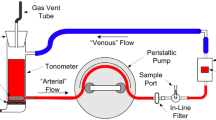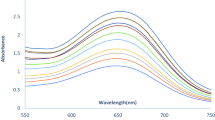Abstract
Objectives. Because the AVOXimeter uses disposable cuvettes and makesits measurements directly in whole blood without first hemolyzing the sample,it does not need the care and maintenance that conventional co-oximetersrequire, it operates faster than conventional co-oximeters, and it is lessexpensive. Therefore, the objectives of this study were (1) to evaluate theprecision and linearity of the AVOXimeter’s measurements of totalhemoglobin concentration and oxyhemoglobin saturation; (2) to assess itslong-term stability and thus the required interval for re-calibration; (3) todetermine whether measurements can be made without anticoagulants; and (4) toassess the feasibility of storing blood samples in the disposable cuvettes.Methods. Measurements made by the test instrument were compared withthose of conventional co-oximeters or with standardized hemoglobin solutions.Blood samples were also collected with and without heparin to determinewhether anticoagulation is necessary. Results. Our tests confirmed thespecified precision of 0.3 g/dl for total hemoglobin and 0.5% foroxyhemoglobin. The results also showed that these measurements were linearwhen compared with a conventional co-oximeter, and they were consistent withthe specified accuracy of 0.45 g/dl for total hemoglobin and 1% foroxyhemoglobin. Weekly checks with control solutions showed that the instrumentholds its calibration for a year or more. Although treating syringes withheparin caused dilution errors, heparin did not affect the measurements whendilution was avoided. When blood samples were placed in disposable cuvettesand read repeatedly at 1-min intervals for 20 min, the readings driftedappreciably away from the original value. This drift occurred so slowly thatreadings taken at the first and second minute after the cuvette was filledwere within 1 or 2% of the original reading. Conclusions. In ourexperience, the test instrument was simple and easy to operate. It met thespecifications for precision and accuracy, its measurements were highlylinear, and it maintained a stable calibration for one year. If the cuvettesare filled as soon as blood is drawn, anticoagulation is unnecessary. However,the cuvettes should be read with 1 min of filling the cuvette.
Similar content being viewed by others
REFERENCES
Gong AK. Near-patient measurement of methemoglobin, oxygen saturation, and total hemoglobin: Evaluation of a new instrument for adult and neonatal intensive care. Critical Care Medicine 1995; 23: 193—201
Freeman GL, Steinke JM. Evaluation of two oximeters for use in cardiac catheterization laboratories. Catheterization and Cardiovasc. Diagnosis 1993; 30: 51—57
Kirshon B, Moise KJ, Jr. Effect of heparin on umbilical arterial blood gases. J Reprod Med 1989; 34: 267—269
Gayed AM, Marino ME, Dolanski EA. Comparison of the effects of dry and liquid heparin on neonatal arterial blood gases. Am J Perinatol 1992; 9: 159—161
Wuillemin WA, Gerber AU. Sources of error in the preanalytical phase of blood gas analysis. Schweiz Rundsch Med Prax 1995; 84: 200—203
Muller-Plathe O, Schreiber R. An electrolyte-adapted heparin solution for the determination of blood gases and electrolytes in whole blood. Anasthesiol Intensivmed Notfallmed Schmerzther 1991; 26: 161—164
Zuerlein TJ. Heparin's effect on blood gas analysis. Am J Dis Child 1990; 144: 168—172
Boidin MR, Jorna P. Influence of different heparin solutions upon blood gas analysis and biochemical values measured in plasma. Intensive Care Med 1984; 10: 255—260
Hutchison AS, Ralston SH, Dryburgh FJ, Small M, Fogelman I. Too much heparin: Possible source of error in blood gas analysis. Br Med J (Clin Res Ed) 1983; 287(6399): 1131—1132
Turton M. Heparin solution as a source of error in blood gas determination. Clin Chem 1983; 29: 1562—1563
Mann SE, Green A. Interference from heparin in commercial heparinised tubes in the measurement of plasma sodium by ion selective electrode: A note of caution. Ann Clin Biochem 1986; 23 (Pt 3): 355—356
Stromme JH, Theodorsen L. Heparin interference in the measurement of gamma-glutamyltransferase activity with the Scandinavian and the IFCC recommended method. Scand J Clin Lab Invest 1985; 45: 437—442
National Committee for Clinical Laboratory Standards: Evaluation of precision performance of clinical chemistry devices. Villanova, PA, NCCLS Document EP5-T2, vol. 12, no.4, 1992
National Committee for Clinical Laboratory Standards: Fractional oxyhemoglobin, oxygen content and saturation, and related quantities in blood: Terminology, measurement, and reporting. Villanova, PA, NCCLS Document C25-T, vol. 12, no.11, 1992
Author information
Authors and Affiliations
Rights and permissions
About this article
Cite this article
Bailey, S.R., Russell, E.L. & Martinez, A. Evaluation of the Avoximeter: precision, long-term stability, linearity, and use without heparin. J Clin Monit Comput 13, 191–198 (1997). https://doi.org/10.1023/A:1007308616686
Issue Date:
DOI: https://doi.org/10.1023/A:1007308616686




